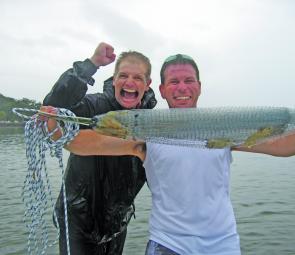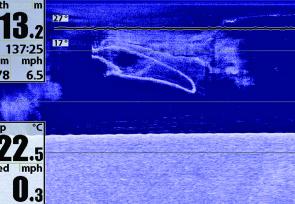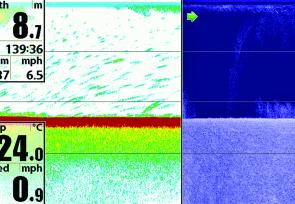Prawning is one of those things that everyone wants to do but only a few ever get really good at. I’m a hack who can cast okay and get a few prawns, but I’ve never experienced that scintillating moment where the top pocket fills up and you haul in half your limit in one cast.
That’s why it’s still exciting to me and my mates. We’re still learning and having a blast while we do it.
Recently Greg Livingstone and I had the chance to talk with and fish with Kord Lucas from L.Wilson and Co. Kord loves his prawning and takes every opportunity he can get to hit the water and get a feed of tasty crustaceans.
We fished on a typically cool, windy and rainy day in April and we thought we’d give you all a few pointers on getting into the game of prawning. These tips can be expanded on, nets upgraded, sounder skills improved and more, but if you’re new to prawning, hopefully you’ll get a few tips that will help you bag a few prawns.
If you talk to the experienced prawners they will tell you there is nothing better than a hand made nylon net without bottom pockets and a streamlined top pocket. This ensures no parachuting of the net as it drifts to the bottom – something that reduces bottom coverage. But in reality, if you’re just starting out a commercially made net that you can buy at any tackle store is all you’ll need. I use a 10ft spread SureCatch monofilament top pocket net, while Kord uses the same SureCatch net except in the 12ft size. Greg Livingstone also uses a 12ft net, having upgraded from an 8ft net used last year. These are easy to buy and are not cost prohibitive to a beginner.
The advantages of a 10-12ft net include a reasonably good spread, they are not restrictively heavy and, with a bit of practice, you can cast them reasonably well most of the fishing session.
Kord said “When I started I used a small net around 6 foot for bait gathering and was a bit nervous of the 12 foot net. But I found I could cast the bigger net reasonably well and even a relatively poor cast gave better coverage than the mini 6 foot net”.
Greg agrees and has been amazed at his success rate with the bigger net.
“I’m not a good caster yet,” said Greg.
“But the 12ft net spreads easier and covers far more ground than my old 8ft one,” said Greg.
There are many types of nets around and the accepted standard for a prawn net is a top pocket net, either with bottom pockets or not. The top pocket collects the prawns as they flip up off the bottom and out of the way of the sinkers that ring the net. As the net draws closed the prawns feel the net mesh and flick further up the net until they enter the top pocket. They then get trapped in the top pocket and are easy to remove.
The case for and against a bottom pocket is still some cause for debate on our boats. I like the bottom pocket because it traps a few extra prawns over the course of a trip. At this stage of my prawning, any extra prawns are good prawns! However, Kord has dispensed with the bottom pocket, even going to the lengths of undoing the bottom pocket on his latest net.
“I just don’t think I get that many more prawns in the bottom pocket and without it I miss out on pulling up all the small stones, shells and weed that bottom pockets collect,” said Kord.
So our consensus is to use a net with a 10-12ft drop that has a top pocket. You get to decide if you want the bottom pocket or not.
This is the biggest key to catching a feed of prawns. You can be the best caster in the world but if the prawns are not below the net, you’ll get nothing.
The best bet is to start in well known areas where prawners have been gathering for years. These are easy to locate with a web search or by talking to your local tackle shop. The closest and most well known spot for me is the powerlines at the mouth of the Logan River. But there are local hot spots all the way up the bay.
Once you have the general area to look, the simplest way to find a prawn is to find the boats casting for them. Prawning is one of the few recreational fishing pursuits where I have seen 30 boats within 50m, all casting nets and happily helping each other out. For someone who is used to seeing the constant angry looks and abuse of average anglers to one another, the prawning fraternity is incredibly uplifting.
So don’t be afraid to fish with the masses. Equally, don’t be silly and drive right into the middle of where everyone is casting. Be polite and you’ll often find a friendly wave over offered and a comment like “get ya net in ‘ere quick!”.
If there are no boats around you’re going to have to find the prawns yourself. If you don’t have a sounder then it’s simply a matter of casting until you come across them, or not. If you have a sounder then you are at a distinct advantage as prawn aggregations show up really well on modern sounders.
Depending on how you set up your colour preferences, assuming a colour sounder is being used, prawns will show up as blue or green mists or blobs close to or on the bottom. Greg calls the mist appearance rain and that’s a pretty good description of what it looks like on the sounder. The blobs of prawns can be very small or quite large, sometimes having a witches hat appearance when they are particularly thick. There are a few screen shots from a Humminbird 977c side imaging unit that clearly show these blobs and the net going down in the water column.
Be aware though that these patterns on a sounder can sometimes turn out to be baitfish. Only time with your sounder and a net will make you more positive in your identification of prawns versus baitfish.
This is the part of prawning that newcomers find the hardest. While this will not help you as you read this, I am yet to see a series of diagrams or images that adequately teach you how to cast a net. The only option as far as I am concerned is to get someone to teach you.
Just about every tackle store will have a staff member who can cast a net well and, if you buy the net from them or are a regular customer, they will be more than happy to teach you the basics.
I can’t offer you the best cast, the easiest cast or the perfect cast as I cannot do any of these, but, importantly, I still get enough prawns to satisfy my needs. This means you can too.
The prawns this year seemed to be patchy, late and early, depending on where you fish. My home waters were a little late this year and as we go to print we can still go out and catch a feed if we are prepared to work a bit.
Usually prawns will be around from late Feb/early March through to the end of May. Their size varies over this period as the wild prawns depend on water conditions and food availability to determine their growth rates. Most are saying the prawns this year have been excellent in regard to size.
The best bet is to get out there this month, do a bit of research and get a feed of prawns for yourself before they disappear. It’s great fun and can be enjoyed by mates or family. Just remember the limits and always be courteous to the other prawners and you’ll be absolutely amazed at their willingness to share the catch around.
Fact Box
Prawn Regulations
There is no size limit on prawns however there is a 10 litres per person limit on take. No more than 10 prawns can be kept with their heads or any other part removed, unless the removal was to process the prawns for immediate consumption.
Reads: 10196
Kord Lucas with an average cast of prawns. These ones came from the Saltworks near Karragarra Island. I may be a bit excited too.

Greg Livingstone loves prawning and when the top pocket starts to fill like this, he’ll be smiling from ear to ear.

A nice bucketful of Southern Bay prawns about to be turned into tasty treats for the whole family.

This incredible screen shot from the Humminbird 977c shows the net falling through the water and hopefully over a bunch of prawns on the bottom.

Blobs and mist are often the only giveaway of prawns being below when they are not thick. Learn your sounder and reap the rewards. Note all the prawns just on or just off the bottom.




